Average skills are no longer enough to get or keep an average job, and you need even more when you are working in the technology-driven world of e-learning. As computers and machines take on almost Orwellian levels of skills and abilities, once adequate human skill sets simply aren't cutting it anymore. To give you and your e-learning team a fighting chance against the machines, learn, love and live these skills to succeed in 2016 and beyond.

1) Adapt and Move with Change
You know how it is when you design a completely perfect eLearning course from the start, and it totally answers the question or solves the problem you were trying to fix, and that same product continues to work without fail for years to come? Yeah, I don’t know how that is and no one else does either because it DOES NOT HAPPEN.
The skills of adaptability and agility are more important than ever because the days of releasing a single product as is and having it solve the problem are gone. Ideas are no longer created in a smoky room and manufactured in secret. We need consumer (learner) input to effectively create products for those consumers and even if by some miracle we do create something useful without outside influence, by the time we release it, it will be outdated.
Progress and development are now measured in degrees with a constant stream of feedback coming in to help us evolve. This is the only real way to keep up with the constantly expanding and changing the world.
Because of this, agility means more than simply going with change; it means seeing change coming and preparing for it ahead of time. This change is an opportunity and must be seen and used as such by becoming comfortable with technology. This is especially true for those of us in eLearning where information and change move at an exceptionally fast pace.
A.D.A.P.T: Forrester Researcher Laura Ramos uses this acronym to remind designers what they should keep in mind.
A-Accept Change
D-Dare the status quo
A-Act Continuously
P-Participate personally
T-Tear down Boundaries
Principal at Kelsey +Co, Margaret Kelsey puts the importance of agility this way:
“For rapid e-learning to be truly and fully adopted, organizations need to examine just how agile they are. A culture willing to embrace both agile theory and rapid e-learning technologies will undoubtedly lead us into the next decade”.[1]
Further reads:
2) Keep an Explorer's Heart
Technology is not just a tool to get tasks done faster; it is also a tool for exploring unknown problems and identifying advantages. Keep in mind that the things you really need to do on a job to stay ahead really can’t be defined in a job description. To stay relevant in you eLearning team, you need to go beyond the minimum requirements and continue learning and increasing your value.
Read: 4 Exercises to Improve Your eLearning Design Skills in 30 Days
3) Embrace Social Media... It Isn't Going Anywhere
Social media platforms are more than just playing Candy Crush and writing scathing reviews of the latest Batman movie in 140 characters or less. No really, they are! Social media is an amazing opportunity to engage students on a platform they are already using and familiar with. As an eLearning designer, you have to see this for the benefit that it is and capitalize by creating courses that use these outlets meaningfully.
One of the best ways to stay ahead of the pack is to engage in social media yourself by joining and interacting in learning communities, forums, and blogs. Internal social networks like Slack or Yammer will help you integrate and engage with your peers by being able to share ideas, conference with team members, collaborate on solutions and increase productivity. Really, the only way to keep current is to feel comfortable with this growing social media, so do not ignore it.
4) Don't Just Date Data, Marry It
You need data and so do your students. The independence and lack of external controls that students feel from eLearning can have many benefits but also a downside. In order to make sure employees are actually retaining info, not just learning it for the course, you need to implement things like tests and quizzes to monitor retention and give feedback to learners. Let them know if the are on the right track and what needs to be improved in order to motivate and give them the tools to problem solve on their own.
This data and feedback benefit you by letting you know when something simply isn’t working in your courses. If you have a thousand learners and only one of them gets a question right that doesn’t mean that person is the smartest, it means your course needs to be tweaked, and your information reexamined. Sometimes things may be too easy to the point that they provide no challenge, and this problem can also be caught.
Read:
5) Collaborate and Listen
The image of the mad scientist or computer geek toiling away in utter seclusion is an outdated one for sure. Very few things are created a single person anymore, especially in the worlds of digital learning and online training. It is more important than ever to listen to peers and experts in your field to fine tune your work. Even more important than simply listening to others is appreciating the benefits of diverse thoughts.
Experienced experts have a lot to offer, but it is often an outsider who can come up with the simplest and best solution.
That being said, it can often be beneficial for team members to work in isolation in order to focus, then reconvene to share. Large teams especially should break off into smaller groups for periods of time. Read more here: Collaboration for Your Teams
Ideas for Collaboration
It’s one thing to talk about getting teams together but how do you actually do it? Here are some ideas to get your teams on board and to think with agility.
- Problem Solving Hangouts: Everyone works a little differently but creating a time for your team to get together and present a project and share their difficulties with it and how they worked through those can be very inspiring.
- Use Collaboration Tools: Authoring tools like SHIFT allow team members to review and comment for quick feedback. Trello also has this feature and will help you more efficiently manage progress with quick review options.
- Forum Watercooler: Blogs and social networks can take the place where water cooler discussions once were. Employees that work remotely from each other or the company at large can often feel isolated and unable to contribute effectively. Having forums that all members can post in helps keep everyone in the loop. Yammer, which is similar to Twitter, is used for businesses and only members with the same corporate domain in their email can login to that company’s network.
- Internal Hackathons or Braninstorm sessions: Companies like Facebook and Google sponsor their own internal hackathons as a way to crowdsource innovation from employee gatherings. For instance, the Facebook “like” button came up in an internal hackathon. Other companies create alternative brainstorming methods like "think week" or public mood boards.
Learn even more about making the most of these emerging trends and how to get your team on board here: Exploit the Latest Trends in Rapid e-Learning and Agile Development.
Bonus: To Stay Ahead You Must Also Be Technology-Driven
This sounds obvious, but when you're in the e-learning industry being techie is a must. Areas of business that were once considered more about people skills are now incorporating almost as much technology as IT divisions. Human resources and training departments, for instance, need to be adept at and willing to learn how to use existing software as well as emerging technology.
Technology helps businesses run in our current landscape and keeps them relevant and current. Your eLearning team CANNOT ignore this technology. For instance, your job as an eLearning professional simply isn’t about being a good writer and planner; you now need to know how to incorporate technology in order to show your clients and colleagues that you are staying relevant on new trends, apps, and tools.
Clients and companies are looking for people that are tech savvy. Without a firm grasp on technology, it’s hard to be even considered for a job, let alone to excel at it. You can’t just come up with the ideas; you also must have a handle on how to execute them and distribute them to your learners. You need to be able to speak eloquently about digital technology to clients [and] stakeholders alike.

REFERENCES:
1. Exploit the Latest Trends in Rapid e-Learning and Agile Develpment. Inside Learning Technologies November 2009 http://www.cedma-europe.org/newsletter%20articles/misc/Exploit%20the%20latest%20trends%20in%20rapid%20e-learning%20and%20agile%20development%20(Nov%2009).pdf
2. Future Work Skills 2020. Institute for the Future for the University of Phoenix Research Institute. http://www.iftf.org/uploads/media/SR-1382A_UPRI_future_work_skills_sm.pdf


